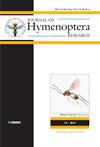Genetic evidence for parthenogenesis in the small carpenter bee Ceratina dallatoreana (Apidae, Ceratinini) in its native distribution range
IF 1.4
3区 农林科学
Q2 ENTOMOLOGY
引用次数: 0
Abstract
Arrhenotoky is the typical mode of reproduction in Hymenoptera. Diploid females develop from fertilized eggs, whereas haploid males originate from unfertilized eggs. However, some taxa of Hymenoptera have evolved thelytoky, in which diploid females originate parthenogenetically from unfertilized diploid eggs. In contrast to some other hymenopteran lineages, like ants and parasitic wasps, thelytoky is generally very rare in bees. Here, we evaluated the frequency of thelytoky in the small carpenter bee Ceratina dallatoreana, which was previously assumed to be thelytokous. By comparing genotypes of microsatellite loci between mothers and their offspring, we found that all female offspring were genetically identical to their mothers. We conclude that parthenogenesis is the prevailing and perhaps obligate mode of reproduction in C. dallatoreana. We also classify the cytological mode of this parthenogenesis as apomixis, or automictic parthenogenesis with central fusion and extremely reduced or non-existing recombination, because offspring showed no decrease of heterozygosity. Because sociality is influenced by relatedness and Ceratina are ancestrally facultatively social, the high relatedness afforded by parthenogenesis should associate with social living in the nest. In accordance with previous work, however, we found no social nests of C. dallatoreana.小木匠蜂Ceratina dallatoreana(Apidae,Ceratinini)单性生殖的遗传证据
单性生殖是膜翅目昆虫的典型繁殖方式。二倍体雌性由受精卵发育而来,而单倍体雄性则由未受精卵发育。然而,膜翅目的一些分类群已经进化出了细胞,其中二倍体雌性从未受精的二倍体卵子中单性生殖。与其他一些膜翅目谱系(如蚂蚁和寄生蜂)不同,这种细胞在蜜蜂中通常非常罕见。在这里,我们评估了小型木匠蜂Ceratina dallatoreana中的thelytoky频率,该蜂以前被认为是thelytokous。通过比较母亲及其后代的微卫星基因型,我们发现所有女性后代的基因与母亲完全相同。我们得出结论,单性生殖是达拉托雷安娜的主要繁殖模式,也许是专性繁殖模式。我们还将这种单性生殖的细胞学模式归类为无融合生殖,或具有中心融合和极为减少或不存在重组的自主单性生殖,因为后代的杂合性没有减少。由于社会性受亲缘关系的影响,而Ceratina是祖先兼性社会性的,单性生殖所提供的高度亲缘关系应该与巢中的社会生活联系在一起。然而,根据之前的工作,我们没有发现达拉托雷安娜的社交巢穴。
本文章由计算机程序翻译,如有差异,请以英文原文为准。
求助全文
约1分钟内获得全文
求助全文
来源期刊
CiteScore
2.60
自引率
15.40%
发文量
68
审稿时长
>12 weeks
期刊介绍:
The Journal of Hymenoptera Research is a peer-reviewed, open-access, rapid online journal launched to accelerate research on all aspects of Hymenoptera, including biology, behavior, ecology, systematics, taxonomy, genetics, and morphology.
All published papers can be freely copied, downloaded, printed and distributed at no charge for the reader. Authors are thus encouraged to post the pdf files of published papers on their homepages or elsewhere to expedite distribution. There is no charge for color.

 求助内容:
求助内容: 应助结果提醒方式:
应助结果提醒方式:


